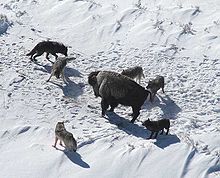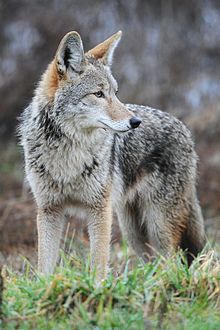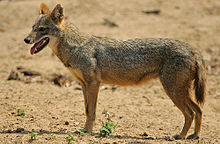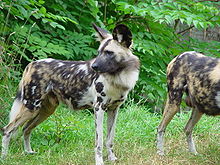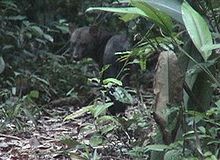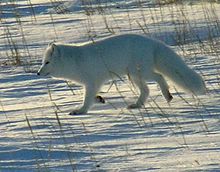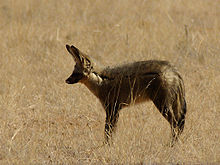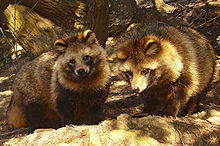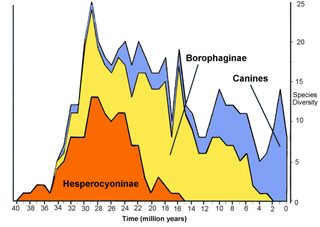- Canidae
-
Canids[1]
Temporal range: 39.75–0 Ma Late Eocene - Recent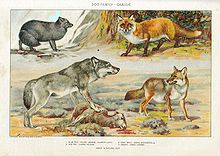
Various canid species: Arctic fox (top left), Red fox (top right), Grey wolf (bottom left) and coyote (bottom right) Scientific classification Kingdom: Animalia Phylum: Chordata Class: Mammalia Order: Carnivora Suborder: Caniformia Family: Canidae
G. Fischer de Waldheim, 1817Genera and species See text
Canidae (
 /ˈkænɨdiː/) [2] is the biological family of carnivorous and omnivorous mammals that includes wolves, foxes, jackals, coyotes, and domestic dogs. A member of this family is called a canid (/ˈkeɪnɨd/). The Canidae family is divided into two tribes: Canini (related to wolves) and Vulpini (related to foxes). The two species of the basal Caninae are more primitive and do not fit into either tribe.
/ˈkænɨdiː/) [2] is the biological family of carnivorous and omnivorous mammals that includes wolves, foxes, jackals, coyotes, and domestic dogs. A member of this family is called a canid (/ˈkeɪnɨd/). The Canidae family is divided into two tribes: Canini (related to wolves) and Vulpini (related to foxes). The two species of the basal Caninae are more primitive and do not fit into either tribe.Contents
Classification and relationship
The subdivision of Canidae into "foxes" and "true dogs" may not be in accordance with the actual relations; also the taxonomic classification of several canines is disputed. Recent DNA analysis shows that Canini (dogs) and Vulpini (foxes) are valid clades. (See phylogeny below). Molecular data implies a North American origin of living Canidae and an African origin of wolf-like canines (Canis, Cuon, and Lycaon).[3]
Currently, the domestic dog is listed as a subspecies of Canis lupus, C. l. familiaris, and the dingo (also considered a domestic dog) as C. l. dingo, provisionally a separate subspecies from C. l. familiaris; the red wolf, eastern Canadian wolf, and Indian wolf are recognized as subspecies.[1] Many sources list the domestic dog as Canis familiaris, but others, including the Smithsonian Institution and the American Society of Mammalogists, more precisely list it as a subspecies of C. l. familiaris; the red wolf, eastern Canadian wolf, and Indian wolf may or may not be separate species; the dingo has been in the past variously classified as Canis dingo, Canis familiaris dingo and Canis lupus familiaris dingo.
Evolution
Evolution of the Canidsview • edit-65 —–-60 —–-55 —–-50 —–-45 —–-40 —–-35 —–-30 —–-25 —–-20 —–-15 —–-10 —–-5 —–0 —←K-T mass extinction←First Hesperocyoninae←First Borophaginae←←Modern-looking dogs[verification needed]←Canine
radiationEocene epoch
Carnivorans evolved from miacoids about 55 million years ago during the late Paleocene.[4] Then, about 50 million years ago, the carnivorans split into two main divisions: caniforms (dog-like) and feliforms (cat-like). By 40 million years ago the first clearly identifiable member of the dog family Canidae had arisen. It was called Prohesperocyon wilsoni and was found in what is now southwestern Texas. This fossil species bears a combination of features that definitively mark it as a canid: teeth that include the loss of the upper third molar (a general trend toward a more shearing bite), and the characteristically enlarged bony bulla (the rounded covering over the middle ear). Based on what we know about its descendants, Prohesperocyon likely had slightly more elongated limbs than its predecessors, along with toes that were parallel and closely touching, rather than splayed, as in bears.[5]
The Canidae family soon subdivided into three subfamilies, each of which diverged during the Eocene: Hesperocyoninae (~39.74-15 Mya), Borophaginae (~34-2 Mya), and the Caninae (~34-0 Mya) lineage that led to present-day canids (wolves, foxes, coyotes, jackals, and domestic dogs). Each of these groups showed an increase in body mass with time, and sometimes exhibited a specialised hypercarnivorous diet that made them prone to extinction.[6]:Fig. 1 Only the Caninae lineage, commonly referred to as "canines", survived to the present day.
Oligocene epoch
By the Oligocene, all three subfamilies of canids (Hesperocyoninae, Borophaginae, and Caninae) had appeared in the fossil records of North America. The earliest and most primitive branch of the Canidae was the Hesperocyoninae lineage, which included the coyote-sized Mesocyon of the Oligocene (38-24 Mya). These early canids probably evolved for fast pursuit of prey in a grassland habitat, and resembled modern civets in appearance. Hesperocyonines eventually became extinct in the middle Miocene. One of the early member of the Hesperocyonines, the genus Hesperocyon, gave rise to Archaeocyon and Leptocyon. These branches led to the borophagine and canine radiations.[7]
Miocene epoch
Around 9-10 Mya during the Late Miocene, Canis, Urocyon, and Vulpes genera expanded from southwestern North America. This was the point where the canine radiation began. The success of these canines was related to the development of lower carnassials that were capable of both mastication and shearing. Around 8 Mya, Beringia offered the canines a way to enter Eurasia.
Pliocene epoch
During the Pliocene around (4-5 Mya) Canis lepophagus appeared in North America. This was small and sometimes coyote-like. Others were wolf-like in characteristics. It is theorized that Canis latrans (the coyote) descended from Canis lepophagus.[8]
The formation of the Isthmus of Panama about 3 Mya joined South America to North America, allowing canids to invade the former, where they diversified.
Pleistocene epoch
Around 1.5 to 1.8 Mya, a variety of wolves were present in Europe. Also, the North American wolf line appeared with Canis edwardii, clearly identifiable as a wolf. Canis rufus appeared, possibly a direct descendent of Canis edwardii. Around 0.8 Mya, Canis ambrusteri emerged in North America. A large wolf, it was found all over the continent. It is thought that this species migrated to South America where it became the ancestor of Canis dirus, the dire wolf.
At 0.3 Mya Canis lupus (the gray wolf) was fully developed and had spread throughout Europe and northern Asia. Beringia offered a way to North America.[9] At around 100,000 years ago, the dire wolf, one of the largest members of the dog family, had spread from South America to southern Canada and from coast to coast. The dire wolf shared its habitat with the gray wolf. Around 8,000 years ago the dire wolf became extinct.
Characteristics
Wild canids are found on every continent except Antarctica, and inhabit a wide range of different habitats, including deserts, mountains, forests, and grassland. They vary in size from the fennec fox at 24 cm (9.4 in) long, to the gray wolf, which may be up to 2 m (6.6 ft) long, and can weigh up to 80 kg (180 lb).
With the exceptions of the bush dog, raccoon dog and some domestic breeds, canids have relatively long legs and lithe bodies, adapted for chasing prey. All canids are digitigrade, meaning that they walk on their toes. They possess bushy tails, non-retractile claws, and, excepting the African wild dog (Lycaon pictus), a dewclaw on the front feet. They possess a baculum, which together with a cavernous body helps to create a copulatory tie during mating, locking the animals together for up to an hour. Young canids are born blind, with their eyes opening a few weeks after birth.[10]
Only a few species are arboreal - the North American gray fox, the closely related Channel Island fox,[11] and the raccoon dog habitually climb trees.[12][13][14]
Social behavior
Almost all canids are social animals and live together in groups. In most foxes and in many of the true dogs, a male and female pair work together to hunt and to raise their young. Gray wolves and some of the other larger canids live in larger groups called packs. African wild dogs have the largest packs, which can number as many as 90 animals. Some species form packs or live in small family groups depending on the circumstances, including the type of available food. In most species, there are also some individuals who live on their own. Within a canid pack, there is a system of dominance so that the strongest, most experienced animals lead the pack. In most cases, the dominant male and female are the only pack members to breed.
Canids communicate with each other by scent signals, by visual clues and gestures, and by vocalizations such as growls, barks, and howls. In most cases, groups have a home territory from which they drive out others. The territory is marked by leaving urine scent marks, which warn trespassing individuals.[15]
Most canids bear young once a year, from 1 to 16 or more (in the case of the African wild dog) at a time. The young are born small and helpless and require a long period of care. They are kept in a den, most often dug into the ground, for warmth and protection. When they begin eating solid food, both parents, and often other pack members, bring food back for them from the hunt. This is most often vomited up from the adult's stomach. Young canids may take a year to mature and learn the skills they need to survive.[16]
Dentition
Most canids have 42 teeth, with a dental formula of:
 . As in other members of Carnivora, the upper fourth premolar and lower first molar are adapted as carnassial teeth for slicing flesh. The molar teeth are strong in most species, allowing the animals to crack open bone to reach the marrow. The deciduous or baby teeth formula in canids is 3 1 3; molars are completely absent.
. As in other members of Carnivora, the upper fourth premolar and lower first molar are adapted as carnassial teeth for slicing flesh. The molar teeth are strong in most species, allowing the animals to crack open bone to reach the marrow. The deciduous or baby teeth formula in canids is 3 1 3; molars are completely absent.Species and taxonomy
FAMILY CANIDAE
Subfamily Caninae
- True dogs - Tribe Canini
- Genus Canis
- Gray wolf, Canis lupus (2.723 Ma to present)
- Domestic dog, Canis lupus familiaris
- Dingo, most often classified as Canis lupus dingo (sometimes considered a separate taxon)
- many other subspecies
- Coyote, Canis latrans (also called Prairie Wolf)
- Ethiopian wolf, Canis simensis (also called Abyssinian wolf, simien fox and simien jackal)
- Golden jackal, Canis aureus
- Side-striped jackal, Canis adustus
- Black-backed jackal, Canis mesomelas
- Gray wolf, Canis lupus (2.723 Ma to present)
- Genus Cuon
- Dhole, Cuon alpinus or Canis alpinus (also called Asian wild dog)
- Genus Lycaon
- African wild dog, Lycaon pictus (also called African hunting dog)
- Genus Atelocynus
- Short-eared dog, Atelocynus microtis
- Genus Cerdocyon
- Crab-eating fox, Cerdocyon thous
- Genus Dusicyon †
- Falklands wolf, Dusicyon australis †
- Genus Lycalopex (Pseudalopex)
- Culpeo, Lycalopex culpaeus
- Darwin's fox, Lycalopex fulvipes
- South American gray fox, Lycalopex griseus
- Pampas fox, Lycalopex gymnocercus
- Sechura fox, Lycalopex sechurae
- Hoary fox, Lycalopex vetulus
- Genus Chrysocyon
- Maned wolf, Chrysocyon brachyurus
- Genus Speothos
- Bush dog, Speothos venaticus
- Genus Canis
- True foxes - Tribe Vulpini
- Genus Vulpes
- Arctic fox, Vulpes lagopus
- Red fox, Vulpes vulpes (1 Ma to present)
- Swift fox, Vulpes velox
- Kit fox, Vulpes macrotis
- Corsac fox, Vulpes corsac
- Cape fox, Vulpes chama
- Pale fox, Vulpes pallida
- Bengal fox, Vulpes bengalensis
- Tibetan sand fox, Vulpes ferrilata
- Blanford's fox, Vulpes cana
- Rüppell's fox, Vulpes rueppelli
- Fennec fox, Vulpes zerda
- Genus Urocyon (2 Ma to present)
- Gray fox, Urocyon cinereoargenteus
- Island fox, Urocyon littoralis
- Cozumel fox, Urocyon sp.
- Genus Vulpes
- Basal Caninae
- Genus Otocyon (probably a vulpine close to Urocyon)
- Bat-eared fox, Otocyon megalotis
- Genus Nyctereutes
- Raccoon dog, Nyctereutes procyonoides
- Genus Otocyon (probably a vulpine close to Urocyon)
Prehistoric Canidae
Classification of Hesperocyoninae from Wang (1994)[17] and Borophaginae from Wang, Tedford, Taylor (1999),[18] and Caninae from Tedford, Wang, Taylor (2009)[19] except where noted.
Caninae
- Tribe Canini[19]
- Genus Canis
- Canis adoxus †
- Canis ameghinoi †
- Canis apolloniensis (1.1 mya) †
- Canis armbrusteri (1.5 mya) †
- Canis arnensis (3.4 Ma, †)
- Canis cautleyi †
- Canis cedazoensis (4.6 mya) †
- Canis dirus (Dire wolf), (1.69 mya) †
- Canis donnezani (4.0-3.1 Ma †, probably ancestor of wolves)
- Canis edwardii (4.6 mya) †, first species of wolf in North America)
- Canis (Eucyon) cipio (8.2 Ma †, probably first species of Canis genus)
- Canis etruscus (3.4 Ma †)
- Canis ferox (5 mya) †
- Canis gezi †
- Canis lepophagus (8 mya)†
- Canis michauxi †
- Canis mosbachensis (0.787 Ma †)
- Canis nehringi †
- Genus Cynotherium †
- Sardinian dhole, Cynotherium sardous †
- Genus Theriodictis (1.19 mya)†
- Genus Protocyon †
- Genus Dusicyon †
- Dusicyon avus †
- Genus Cerdocyon
- Cerdocyon avius †
- Cerdocyon ensenadensis †
- Genus Speothos
- Genus Nurocyon †
- Nurocyon chonokhariensis †
- Genus Xenocyon †
- Xenocyon falconeri (2.6 Ma †)
- Xenocyon lycaonoides (1.69 mya) †
- Genus Canis
- Tribe Vulpini
- Basal Caninae
- Genus Nyctereutes (7.1 Ma to present)
- First Caninae
Borophaginae
† (Ma = million years ago) (million years = in existence)
- Tribe Phlaocyonini (27.2 million years) †
- Genus Cynarctoides (16.7 million years) †
- Cynarctoides acridens (11 million years) †
- Cynarctoides emryi (4 million years) †
- Cynarctoides gawnae (4 million years) †
- Cynarctoides harlowi (4 million years) †
- Cynarctoides lemur (30 Ma) †
- Cynarctoides luskensis (4.2 million years) †
- Cynarctoides roii (4.5 million years) †
- Genus Phlaocyon (30-19 Ma)
- Phlaocyon achoros
- Phlaocyon annectens (22 Ma)
- Phlaocyon latidens (30 Ma)
- Phlaocyon leucosteus (22 Ma)
- Phlaocyon mariae
- Phlaocyon marslandensis (19 Ma)
- Phlaocyon minor (30 Ma)
- Phlaocyon multicuspus
- Phlaocyon taylori[20]
- Phlaocyon yakolai (19 Ma)
- Genus Cynarctoides (16.7 million years) †
- Tribe Borophagini (16.7 million years) †
- Genus Cormocyon (10.2 million years) †
- Genus Desmocyon (9 million years) †
- Genus Metatomarctus (4.3 million years) †
- Genus Eulopocyon (18-16 Ma)
- Eulopocyon brachygnathus (16 Ma)
- Eulopocyon spissidens (18 Ma)
- Genus Psalidocyon (16 Ma)
- Psalidocyon marianae (16 Ma)
- Genus Microtomarctus (4 million years) †
- Genus Protomarctus (18 Ma)
- Protomarctus optatus (18 Ma)
- Genus Tephrocyon (16 Ma)
- Tephrocyon rurestris (16 Ma)
- Subtribe Cynarctina †
- Subtribe Aelurodontina (15 million years) †
- Subtribe Borophagina (17 million years) †
- Genus Paratomarctus (6 million years) †
- Paratomarctus euthos (13 Ma)
- Paratomarctus temerarius (16 Ma)
- Genus Carpocyon (19.7 million years) †
- Genus Protepicyon (16 Ma)
- Protepicyon raki (16 Ma)
- Genus Epicyon (2 million years) †
- Genus Borophagus (7 million years) †
- Borophagus diversidens (5 Ma) †
- Borophagus dudleyi (1.7 million years) †
- Borophagus hilli (6.7 million years) †
- Borophagus littoralis (0.6 million years) †
- Borophagus orc (0.4 million years) †
- Borophagus parvus (5.4 million years) †
- Borophagus pugnator (8.3 million years) †
- Borophagus secundus (8.3 million years) †
- Genus Paratomarctus (6 million years) †
Hesperocyoninae
-
- Genus Cynodesmus (32-29 Ma)
- Cynodesmus martini (29 Ma)
- Cynodesmus thooides (32 Ma)
- ?Genus Caedocyon
- Caedocyon tedfordi
- Genus Ectopocynus (32-19 Ma)
- Ectopocynus antiquus (32 Ma)
- Ectopocynus intermedius (29 Ma)
- Ectopocynus siplicidens (19 Ma)
- Genus Enhydrocyon (29-25 Ma)
- Enhydrocyon basilatus (25 Ma)
- Enhydrocyon crassidens (25 Ma)
- Enhydrocyon pahinsintewkpa (29 Ma)
- Enhydrocyon stenocephalus (29 Ma)
- Genus Hesperocyon (39.74-34 Ma)
- Hesperocyon coloradensis
- Hesperocyon gregarius (37 Ma)
- Genus Mesocyon (34-29 Ma)
- Mesocyon brachyops (29 Ma)
- Mesocyon coryphaeus (29 Ma)
- Mesocyn temnodon
- Genus Osbornodon (32-18 Ma)
- Osbornodon brachypus
- Osbornodon fricki (18 Ma)
- Osbornodon iamonensis (21 Ma)
- Osbornodon renjiei (33 Ma)
- Osbornodon scitulus[22]
- Osbornodon sesnoni (32 Ma)
- Osbornodon wangi[20]
- Genus Paraenhydrocyon (30-25 Ma)
- Paraenhydrocyon josephi (30 Ma)
- Paraenhydrocyon robustus (25 Ma)
- Genus Philotrox (29 Ma)
- Philotrox condoni (29 Ma)
- Genus Prohesperocyon (36 Ma)
- Prohesperocyon wilsoni (36 Ma)
- Genus Sunkahetanka (29 Ma)
- Sunkahetanka geringensis (29 Ma)
- Genus Cynodesmus (32-29 Ma)
Canids and humans
One canid, the domestic dog, a subspecies of the gray wolf, long ago entered into a partnership with humans and today remains one of the most widely kept domestic animals in the world and serves humanity in a great many important ways.
Among canids, only the gray wolf has been known to prey on humans.[23] There are at least two records of coyotes killing humans,[24] and two of golden jackals killing children.[25] Some canid species have also been trapped and hunted for their fur and, especially the gray wolf and the red fox, for sport. Some canids are now endangered in the wild due to hunting, habitat loss, and the introduction of diseases from domestic dogs.[26]
See also
References
- ^ a b Wozencraft, W. Christopher (16 November 2005). "Order Carnivora (pp. 532-628)". In Wilson, Don E., and Reeder, DeeAnn M., eds. Mammal Species of the World: A Taxonomic and Geographic Reference (3rd ed.). Baltimore: Johns Hopkins University Press, 2 vols. (2142 pp.). ISBN 978-0-8018-8221-0. OCLC 62265494. http://www.bucknell.edu/msw3/browse.asp?id=14000691.
- ^ Canidae. Dictionary.com. The American Heritage Stedman's Medical Dictionary. Houghton Mifflin Company. http://dictionary.reference.com/browse/Canidae (accessed: February 16, 2009).
- ^ Lindblad-toh, K.; Wade, CM; Mikkelsen, TS; Karlsson, EK; Jaffe, DB; Kamal, M; Clamp, M; Chang, JL et al. (2005). "Genome sequence, comparative analysis and haplotype structure of the domestic dog" (PDF). Nature 438 (7069): 803–819. doi:10.1038/nature04338. PMID 16341006. http://ccr.cancer.gov/resources/cop/nature04338.pdf. Retrieved 2008-04-27.
- ^ http://paleodb.org/cgi-bin/bridge.pl?action=checkTaxonInfo&taxon_no=57534&is_real_user=1
- ^ Wang, Xiaoming (2008). "How Dogs Came to Run the World". Natural History Magazine July/August. http://www.naturalhistorymag.com/master.html?http://www.naturalhistorymag.com/0708/0708_feature.html. Retrieved 2008-11-28.
- ^ Van Valkenburgh, B.; Wang, X.; Damuth, J. (Oct 2004). "Cope's Rule, Hypercarnivory, and Extinction in North American Canids". Science 306 (5693): 101–104. Bibcode 2004Sci...306..101V. doi:10.1126/science.1102417. ISSN 0036-8075. PMID 15459388.
- ^ Martin, L.D. 1989. Fossil history of the terrestrial carnivora. Pages 536 - 568 in J.L. Gittleman, editor. Carnivore Behavior, Ecology, and Evolution, Vol. 1. Comstock Publishing Associates: Ithaca.
- ^ Nowak, R.M. 1979. North American Quaternary Canis. Monograph of the Museum of Natural History, University of Kansas 6:1 - 154.
- ^ Nowak, R. 1992. Wolves: The great travelers of evolution. International Wolf 2(4):3 - 7.
- ^ Macdonald, D. (1984). The Encyclopedia of Mammals. New York: Facts on File. pp. 57. ISBN 0-87196-871-1.
- ^ http://animaldiversity.ummz.umich.edu/site/accounts/information/Urocyon_littoralis.html
- ^ Kauhala K. & Saeki M. (2004). »Raccoon Dog«. Canid Species Accounts. IUCN/SSC Canid Specialist Group. Pridobljeno 15.4.2009.
- ^ Ikeda, Hiroshi (August 1986). "Old dogs, new tricks: Asia's raccoon dog, a venerable member of the canid family is pushing into new frontiers". Natural History 95 (8): p40,44.
- ^ Raccoon dog – Nyctereutes procyonoides. WAZA – World Association of Zoos and Aquariums.
- ^ Nowak, R. M., and J. L. Paradiso. 1983. Walker's Mammals of the World. Baltimore, Maryland: The Johns Hopkins University Press. ISBN 0801825253.
- ^ Voelker, W. 1986. The Natural History of Living Mammals. Medford, New Jersey: Plexus Publishing. ISBN 0937548081
- ^ Wang, Xiaoming (1994). "Phylogenetic systematics of the Hesperocyoninae". Bulletin of the American Museum of Natural History 221: 1–207. hdl:2246/829.
- ^ Wang, Xiaoming; Wideman, Benjamin C.; Nichols, Ralph; Hanneman, Debra L. (1999). "Phylogenetic systematics of the Borophaginae". Bulletin of the American Museum of Natural History 243 (2): 1–391. doi:10.1671/2493. hdl:2246/1588.
- ^ a b Tedford, Richard; Xiaoming Wang, Beryl E. Taylor (2009). "Phylogenetic systematics of the North American fossil Caninae (Carnivora: Canidae)". Bulletin of the American Museum of Natural History 325: 1–218. doi:10.1206/574.1.
- ^ a b Hayes, F.G. (2000). "The Brooksville 2 local fauna (Arikareean, latest Oligocene) Hernando County, Florida". Bulletin of the Florida Museum of Natural History 43 (1): 1–47.
- ^ Wang, Xiaoming; Wideman, Benjamin C.; Nichols, Ralph; Hanneman, Debra L. (2004). "A new species of Aelurodon (Carnivora, Canidae) from the Barstovian of Montana" (PDF). Journal of Vertebrate Paleontology 24 (2): 445–452. doi:10.1671/2493. Archived from the original on September 30, 2007. http://web.archive.org/web/20070930021020/http://www.nhm.org/expeditions/rrc/wang/documents/Wangetal2004MontanaAelurodon.pdf. Retrieved 2007-07-08.
- ^ Wang, Xiaoming (2003). "New Material of Osbornodon from the Early Hemingfordian of Nebraska and Florida" (PDF). Bulletin of the American Museum of Natural History 279: 163–176. doi:10.1206/0003-0090(2003)279<0163:C>2.0.CO;2. http://digitallibrary.amnh.org/dspace/bitstream/2246/447/19/B279a08.pdf.
- ^ Kruuk, H. 2002. Hunter and Hunted: Relationships between Carnivores and People. Cambridge, UK: Cambridge University Press. ISBN 0521814103.
- ^ "Coyote Attacks: An Increasing Suburban Problem". Archived from the original on February 24, 2006. http://web.archive.org/web/20060224153601/http://www.co.san-diego.ca.us/awm/docs/coyoteattacks.pdf. Retrieved 2007-08-19.
- ^ "Canis aureus". Animal Diversity Web. http://animaldiversity.ummz.umich.edu/site/accounts/information/Canis_aureus.html. Retrieved 2007-07-31.
- ^ ICUN Red List
General references
- Xiaoming Wang, Richard H. Tedford, Mauricio Antón, Dogs: Their Fossil Relatives and Evolutionary History, New York : Columbia University Press, 2008; ISBN 978-0-231-13528-3
External links
- Canidae at National Center for Biotechnology Information (NCBI) website.
- African Wild Dog Conservancy
Categories:- Canids
- Mammal families
- True dogs - Tribe Canini
Wikimedia Foundation. 2010.

